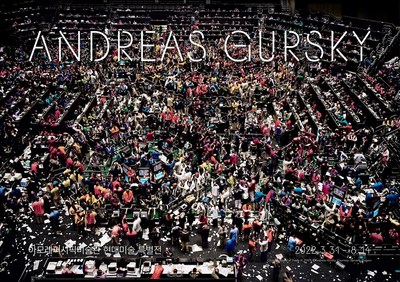Amorepacific Museum of Art opens Andreas Gursky exhibition, unveiling latest works for the first time
Comunicato Precedente

Comunicato Successivo

Andreas Gursky, the German master of contemporary photography, is known for his large format photographs that convey deep insights into humanity and civilization. He sets his focus on places such as skyscrapers, factories, apartments blocks, and even scenes at stock exchange markets that symbolize modern civilization, inviting viewers to contemplate the role of individuals amidst this vast society. This show encapsulates the noble and sublime aspirations of Gursky, whom, through his works has recorded people in vast spaces including natural landscapes and architecture and thereby has achieved capturing a dimension of modern civilization.
Born in Leipzig, Germany, Gursky studied typological photography under Bernd and Hilla Becher who established the aesthetics and tradition of modern German photography at the Kunstakademie Düsseldorf. Unlike his early works that depicted painterly landscapes taken from his surroundings, his 1990s works incorporate digital post-production technique of editing and blending images together. Ever since, he continues to mediate between boundaries and has explored the characteristics of abstract paintings and minimalistic sculptures to gradually break down the conventional definition of photography.
APMA displays 40 works by Gursky that have been taken over a period of 40 years, including Paris, Montparnasse (1993), 99 Cent (1999, remastered in 2009) and his latest works Eisläufer (2021) and Streif (2022). The exhibition will take place across seven rooms under different themes like Constructed Image, Art Historical References, and Sublime Aspirations.
The representative of APMA said, "The retrospective hopes to shed light on the artist's career and will provide a remarkable opportunity to gauge the direction of his future artistic steps. As a museum that seeks to constantly reestablish itself as an artistic and inspirational platform for creative communication, we, at APMA sincerely hope that this exhibition will renew the public recognition of photography as an important genre in contemporary art and serve as an inspiration to the Korean art scene."
[Exhibition overview]

[Reference] About Amorepacific Museum of Art (APMA)
The Amorepacific Museum of Art (APMA) had its beginnings in a small collection of craftworks and ceramics related to women, cosmetics, and green tea of the late Amorepacific founder, Suh Sung-hwan (1924-2003), who had compiled these items in an effort to preserve and promote Korean traditions. He opened the Pacific Museum in 1979 and 30 years later, the museum was rebranded into the Amorepacific Museum of Art in 2009. During those years, the museum has continued to pursue the advancement of art and culture by holding exhibitions, conducting R&D, publishing, and carrying out support projects as a museum for both historic and modern art from the East and the West.
In 2018, APMA was newly opened after it moved to the Amorepacific head office in Yongsan, Seoul. An art museum is a place of communication itself with artists, and visitors using the common language of art. It is also a space that is open to all. The first floor of the museum boasts various facilities including the lobby, a museum shop, APMA Cabinet, a show room, and apLAP, a global exhibition catalog. When you step into the exhibition rooms, you can view the diverse range of items on show that tell stories of ancient Korean art, modern art, and international art. Starting with APMA, The Beginning, which started when the museum opened in 2018, APMA has since held numerous shows including Rafael Lozano-Hemmer: Decision Forest, Beyond Folding Screens , APMA, Chapter One, Barbara Kruger: Forever, APMA, Chapter Two, APMA, Chapter Three, and Mary Corse : Painting with Light.
The Amorepacific headquarters in Yongsan, Seoul, was designed by world-renowned British architect, David Chipperfield. He expressed the singular beauty of the head office, which is not seen anywhere else in the city. Instead of being very tall or consisting of many buildings, the Amorepacific headquarters is simple and elegantly built as a single, large piece of architecture. It is reminiscent of the beauty of the white Moon Jar (a porcelain piece from the Joseon dynasty) that gives off a comfortable yet rich feeling despite being simple without any fancy decorations. Visitors to APMA will have a special experience of seeing works of art from Korea and abroad at the beautifully built architectural piece by David Chipperfield.
APMA seeks to contribute to the advancement of Korea and global art and culture. They plan to promote the traditional and modern art of Korea to local and world audiences, and to introduce the latest art trends from overseas, all while conducting research and supporting other relevant projects.
Photo - https://mma.prnewswire.com/media/1776564/Andreas_Gursky.jpg





